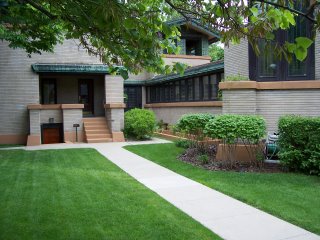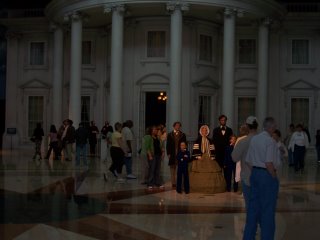The Dana-Thomas House was built in the early 1900s for Susan Dana, a rich suffragist. Naturally, that's not the reason the house has been preserved, because being involved in the community and the women's movement is not enough reason to be remembered. Nope, the house is now a historical site because its architect was Frank Lloyd Wright. The tour started with a video, which basically went something like this:
- Wright's early life
- Wright's creative genius
- A quick reference to Dana and how she let Wright express his genius with her money
- More of Wright's designs
It also went into a quick bio of Dana which basically describes her as a rich woman who goes through several husbands (one of them 22 years younger) and then dies alone and broke in a hospital. Apparently, that's what happens when women have money: they mismanage it and waste it (but that's okay because Frank Lloyd Wright benefitted). The tour was a little more balanced, and talked more about her life and the contributions that Dana made to her community. As for Wright, he was a bit of a control freak: he built some of the furniture into the house itself so that it couldn't be removed and mess up his orginal intent. So much for rearranging.

The Lincoln Museum wasn't bad but the wax figures were kind of freaky. It had a lot of information but it seemed like it might be better for children and school field trips (or perhaps my history degree has ruined me for life). There was one room which used wax figures to show a slave auction. The slave dealer looked demonic, and the red spot light only reinforced that impression. It seems like there could maybe be a less simplistic way of portraying history but that could just be me. Another room showed Lincoln and Mary Todd at their son's death bed. The background music sounded like carousel music. It was very creepy - I was expecting the clown from It to jump up out of the corner. I liked one of the displays a lot, though: there was a picture gallery of different war images with interactive computer screens that went into more detail about the pictures. Overall, the museum seemed like the slightly sanitized version of history. For example, The First Lady Gallery (a special, temporary display) gave a short bio of each First Lady but it focused on the positive. In the case of Betty Ford, it talked about her involvement in the Betty Ford Center but ignored the fact that she herself had dealt with alcoholism. While the dresses were neat, for the most part, the entire First Lady's display just involved walking around the room, reading posterboards with short bios. Aren't there books for that?

See what I mean by creepy?
No comments:
Post a Comment